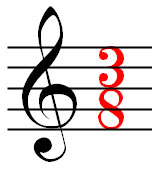 If you look at a piece of music one of the very first things you will see are two numbers – it almost looks like a fraction. Some common time signatures you have undoubtedly seen before are 4/4 or 3/8 , these are not just arbitrary numbers, and they have a very important role in the timing of the piece.
If you look at a piece of music one of the very first things you will see are two numbers – it almost looks like a fraction. Some common time signatures you have undoubtedly seen before are 4/4 or 3/8 , these are not just arbitrary numbers, and they have a very important role in the timing of the piece.
But what do these numbers mean? Well the top number is easy; it tells you how many beats are in each measure – so in 3/8 time it you would have 3 beats per measure.
But what does the bottom number mean? When teaching, I sometimes refer to it as the mystery number because it surprises me how many students don’t know what it actually means! So in the example of 3/8 time, the bottom number 8 represents the kind of note getting ONE beat. So let’s break this down so it’s easier to understand. Here is the guide for what the bottom note stands for:
1 = Whole Note
2 = Half Note
4 = Quarter Note
8 = Eighth Note
16 = Sixteenth Note
32 = Thirty-second Note
64 = Sixty-fourth Note
128 = One-hundred-twenty-eighth Note
 How many beats in each measure
How many beats in each measure
Kind of note getting ONE beat
3 – There are 3 beats in a measure
8 – An eighth Note Gets ONE beat
Now one thing you would never see is something like 4/3 or 4/7 time because there is no 3rd or 7th note that exists in music – the bottom number will always represent the kind of note getting one beat.
Hopefully, this is of some help for those of you wondering how to read your time signatures. Feel free to contact me if you have any more questions: Robert@LivingPianos.com (949) 244-3729
2 thoughts on “How to Read Time Signatures in Music”









But you’ve missed the entire idea that a 4 in the bottom implies a duplet default subdivision, and an 8 at the bottom implies a triplet default subdivision. So when in an 8 at the bottom time signature, there is a difference between what most people call the beat (the eighth note), and what the “heard” beat really is (the dotted quarter note).
You make a very good point about the rhythmic feel of a piece. 3/4 time can also be felt as a piece in 1 at faster tempos. The simple mathematics of time signatures are essential for figuring out rhythms. But you are absolutely right – this is only the beginning. Context is everything!